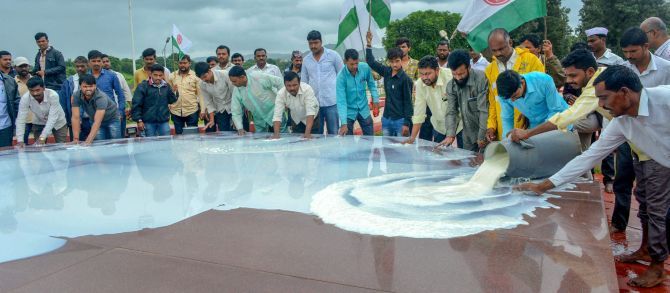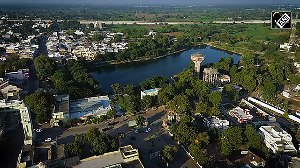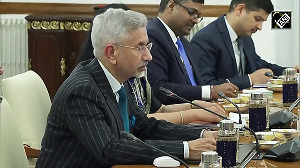'We are not talking pennies. The milk business is as large as the automobile industry (about Rs 4 trillion in sales),' points out T N Ninan.

India has moved from famines and agricultural shortages to surpluses.
The country produces more food than it can consume: More rice, more sugar, more milk, and frequently more tomatoes, onions and potatoes.
There are 68 million tonnes of wheat and rice in stock, more than twice what buffer stocking norms require.
Milk production has been growing at four times the rate of population growth.
That's true of potatoes too, whose production has increased by 80 per cent in a decade, while the population has grown by less than 20 per cent.
Sugar output this year is expected to be 32 million tonnes when consumption usually is 25 million tonnes.
The result is that you have farmers pouring tanker-loads of surplus milk down highways in protest at low prices (this in the lean summer season, when milk output falls).
Or leaving unwanted potatoes in cold stores; the store owners then dump thousands of tonnes of the stuff out in the open, to rot.
It is crazy for the country to have such surpluses when per capita consumption of most food items is low. But consumption levels are mostly hard-coded into income levels.
The government could take steps to boost consumption, but the main foodgrains are already being sold at 10 per cent of cost.
You could increase milk consumption by including it in mid-day meal programmes in schools. The likelihood though is that there will still be surpluses.
You could export, and India happens to be the leading exporter of rice, and a significant exporter of some other food items. But our agriculture is mostly uncompetitive because productivity is low.
China grows two-and-a-half times the tomatoes that India does, on slightly higher acreage.
When productivity does go up, as it has with sugar, the problem of surplus gets worse.
Many billions of rupees are already owed by sugar mills to cane growers, but the government proposes to subsidise exports and stock sugar on the mills' part while raising cane prices further!
There is also the growing awareness that when you export rice and sugar, you are exporting the large quantities of water used in their production -- at a time when the country's water shortage threatens to become a crisis.
We are not talking pennies. The milk business is as large as the automobile industry (about Rs 4 trillion in sales).
The sugar business is not small either. And what has come to be called TOP (tomatoes, onions and potatoes) equals three-quarters of rice tonnage.
Yet the problem goes beyond economics because it involves millions of farmers, and the human crisis gets refracted through political prisms.
You then get responses like the latest hike in rice procurement prices and states offering subsidies on milk production.
This will encourage more paddy cultivation and more milk production, when policy should be pointing farmers the other way.
Other distortions multiply. Apart from subsidies, government intervention usually means unrealistically high prices as in the case of sugarcane, excessive stocking, price and movement controls, and the writing off of farmers' loans.
All of it is aimed at helping farmers to earn minimum incomes, or protecting them from market vagaries. But these are unsustainable without heavy cost.
Lasting solutions involve changing the demand-supply mix for the surplus products, by diversifying cropping into new products including those where the country imports what it needs (oilseeds, pulses).
There has been some movement in this direction, but not enough.
The output growth rate for pulses, after years of stagnation, has reached a handsome 4 per cent, when looked at over a decade.
Oilseeds output growth has been slower, but even that is a change from the earlier stagnation.
And TOP, plagued by sharp boom-bust scenarios (both phases of the price cycle hurt farmers), has a government scheme announced in the Budget: Operation Green, to copy milk's Operation Flood by encouraging producer cooperatives, and more processing of fresh produce.
It will take years to make a difference, but there is no other way to move beyond policies born of a shortage mentality and come into the modern age.











